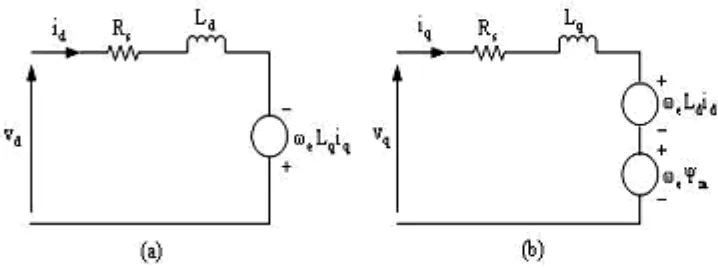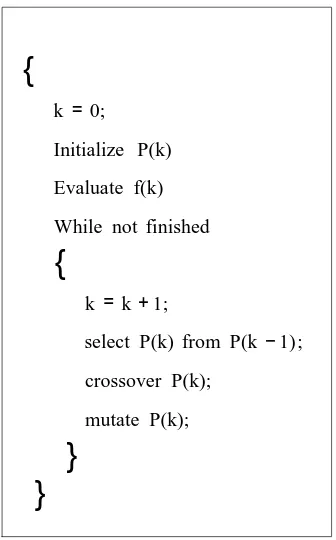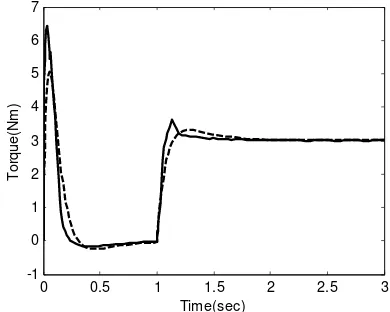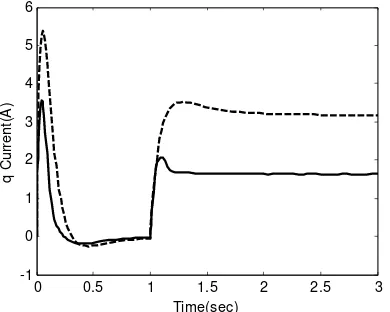ISSN: 1693-6930
accredited by DGHE (DIKTI), Decree No: 51/Dikti/Kep/2010 237
Maximum Torque per Ampere Control of Permanent
Magnet Synchronous Motor Using Genetic Algorithm
Farzad Tahami*1, Hamed Nademi2, Mohammad Rezaei2
1
Department of Electrical Engineering, Sharif University of Technology, Tehran, Iran Azadi Ave, Tehran 14567-17368, Iran , telp/fax: +98-21-66165961/ 66023261
2
Electrical and Electronics Engineering Complex, Malek Ashtar University of Technology Lavizan, Tehran, Iran
e-mail: [email protected]*1, [email protected]
Abstract
Pengemudian motor sinkron magnet permanen (PMSM) mempunyai banyak keuntungan dibandingkan pengemudian motor lainnya, misal efisiensi tinggi dan kerapatan daya tinggi. Khususnya, PMSM adalah membuka peradaban baru dan semakin intensif dipelajari para peneliti, ilmuwan dan insinyur. Makalah ini menguraikan sebuah pengendali baru unjuk kerja tinggi berbasis algoritma genetik. Skema ini memungkinkan motor dikemudikan dengan karakteristik torsi per ampera maksimum. Makalah ini dengan asumsi fungsi fitness yang tepat, nilai optimal untuk arus listrik sumbu-d dari set poin motor di setiap waktu ditemukan dan kemudian diterapkan ke pengendali. Hasil simulasi menunjukkan keberhasilan operasi dari pengendali yang diusulkan.
Keywords: algoritma genetik, kendali berorientasi medan, motor sinkron magnet permanen
Abstract
Permanent magnet synchronous motor (PMSM) drives have many advantages over other drives, i.e. high efficiency and high power density. Particularly, PMSMs are epoch-making and are intensively studied among researchers, scientists and engineers. This paper deals with a novel high performance controller based on genetic algorithm. The scheme allows the motor to be driven with maximum torque per ampere characteristic. In this paper assuming an appropriate fitness function, the optimum values for d-axis current of motor set points at each time are found and then applied to the controller. Simulation results show the successful operation of the proposed controller.
Keywords: field oriented control, genetic algorithm, permanent magnet synchronous motor
1. Introduction
In recent years, the permanent-magnet synchronous motor (PMSM) has become increasingly popular for use in high-performance drive applications due to desirable features such as high torque-to-current ratio, high power-to-weight ratio, high efficiency, low noise, and robust operation. The advantageous features of the PMSM for modern drives applications are well established [1, 2]. Their fast and accurate speed response, quick recovery of speed from any disturbance, and insensitivity to parameter variations are some of the important criteria for high-performance drive systems used in robotics, rolling mills, machine tools, and electric vehicles.
component of the stator current equal to zero (id =0). Since the “id =0 control” prevents the demagnetization of the PM, it is often employed in interior PM motor drives. However, the id current, that provides maximum torque-per-ampere current ratio in interior PM motor drives, is a function of the iqcurrent and opposes the excitation field of the PM [8]-[10]. But there is not any
efficient analytic mechanism to obtain a certain mathematical relation between id and iq.
On the other hand, the optimal control of permanent magnet synchronous motors requires the accurate knowledge of the machine parameters. Generally, the magnetic parameters depend on the saturation level. For machines with interior magnets, all magnetic parameters (Ld,LqandΨm) show a significant variation with load current [11]. In this paper we use intelligent optimization methods. Intelligent approaches are widely used to control PMS motors in the recent decade [12, 13]. Genetic Algorithms (GA’s) is one the most efficient methods for this application. In [14, 15] a GA is used to optimize the PID parameters of the controller. In this work, a new idea is proposed where maximum output torque is ensured with minimum stator current. An unknown function for d-axis current is derived in terms of q-axis current based on maximum torque per ampere criteria. The unknown function is then optimized by a GA including a fitness function, torque per ampere. In this approach the PID controller determines iq and then id will be determined by multiplying iq and the optimized unknown
function. This paper is organized as follows; In section 2 the approximate model of the PMS motor is presented. GA optimization method is presented in section 3. Simulation results are presented in section 4. In section 5, the paper is concluded.
2. PMSM Dynamics
The mathematical model of a PMSM in the d-q synchronously rotating reference frame for assumed sinusoidal stator excitation is given as [13]:
q
R : resistance of the stator windings
q
i ,id: q and d axis currents
q
v ,vd: q and d axis voltages
e
ω : angular velocity of the rotor
m
Ψ : maximum flux linkage due to rotor permanent magnet p: number of poles
e
T : electromagnetic torque
Figure 1. Equivalent circuit of IPM motors; (a) d-axis circuit, (b) q-axis circuit
Figure 2. Block diagram of the complete PMSM drive system with the proposed controller
This saliency term is negligible in surface mounted permanent magnet motors. In the case of an interior permanent magnet motor where Lq not equal to Ld, the torque per ampere
rating is boosted by the saliency torque term. In motoring operation, a negative id injection (as
d
q L
L > ) will contribute to the increase in reluctance torque. Efficient utilization of this
reluctance torque component of (3) is most critical for intensive flux weakening operations and efficiency improvement at high speed in hybrid electric vehicles [16] and electric traction drives [17].
The output power is expressed as:
m q i d i q L d L q i m p m e T
Po ω [ ( ) ]ω
4 3
− + Ψ =
= (4)
where:
e m
pω ω = 2
(5)
e metaphor of natural biological evolution. GA operates on a population of potential solutions applying the principle of survival of the fittest solution [18]. At each generation, a new set of potential solution is created by the process of selecting individuals according to their fitness in the problem domain and manipulating them like natural genetics.
This process leads to the evolution of populations of individuals that are better suited to their environment than the prior individuals, just as in natural adaptation. This technique is especially useful for complex optimization problems with a large number of parameters that make global analytical solutions difficult to obtain. The main operations of GA are initialization, fitness evaluation, selection, mutation and crossover. Figure 3 shows the procedure of GA.
P(k) represents the population at stage k and f(k) represents the fitness evaluation of the population P(k). According to evolutionary theories, only the most suited elements in a population are likely to survive and generate offspring thus transmitting their biological heredity to new generations [19]. A GA maps a problem onto a set of strings (the chromosomes), each string represent a potential solution.
Figure 3. The simplified procedure of GA
The three most important aspects of using GAs are: (1) definition of the objective function, (2) definition and implementation of the genetic representation, and (3) definition and implementation of the genetic operators.
3.1. Genetic Algorithm Operations
A) Selection - The purpose of parent selection in a GA is to give more reproductive changes to those individuals that are the fit. There are many ways to do it, but one commonly used technique is roulette wheel parent selection (RWS). A second very popular way of selection is stochastic universal sampling (SUS) [18]. This way is a single-phase algorithm with minimum spread and zero bias. In this work, we will use SUS.
B) Crossover (Recombination) - The basic operator for producing new chromosomes in GA is crossover. Like its counterpart in nature, crossover produces new individuals that have some parts of both parent’s genetic material. Single-point crossover, multipoint crossover, uniform crossover, line recombination and intermediate recombination are various crossover techniques [20]. In this study, single–point crossover has been employed. The crossover probability is set to ρc.
C) Mutation - In natural evolution, mutation is a random process where one allele of a gene is replaced by another to produce a new genetic structure. In GA, mutation modifies elements in the chromosomes randomly with low probabilityρm, typically in the range 0.001 and 0.01, and modifies element in the chromosomes. The main role of mutation is to provide a guarantee that the probability of searching any individual will never be zero and to recover good genetic material that may be lost through the action of selection and crossover [18].
D) Reinsertion - Once selection and recombination of individuals from the old population have produced a new population, the fitness of the individuals in the new population may be determinate. If fewer individuals are produced by recombination than the size of the original population, then the fractional difference between the new and old population sizes in termed a generation gap. To maintain the size of the original population, the new individuals have to be reinserted into the old population. Similarly, if not all the new individuals are to be used at each generation or if more offspring are generated than size of old population then a reinsertion scheme must be used to determine which individuals are to exist in the new population. When selecting which members of the old population should be relocated the most apparent strategy is to replace the least fit members deterministically. The replacement should select and replace the oldest members of the population [18].
3.2. Fitness Function
To select the best suited solution, a criterion is needed. This criterion is fitness function [18]. In control applications, the fitness function is generally referred to minimization of the error between the desired and the real output. As maximum torque per ampere is the main objective in our control strategy, the following function is chosen as a fitness function.
( )
( )
∑
= =
0 ) (
t Is t t T i
fitness
(7)
So, (7) is the fitness function should be optimized using GA. In other word GA determines the unknown function,F(iq)at each moment to get the best fitness function and
then id determine by multiplying iq and optimized F(iq).
4. Results and Discussion
The proposed control system has been applied to the PMS motor with parameters as tabulated in Table 1. The simulations have been implemented in the Matlab-Simulink software. Here the proposed controller is compared with a conventional PI controller withKP =0.1,KI =0.3. A genetic algorithm with population size of 100 and ρc=1,ρm =0.01 is
chosen as an optimizer. Initial population is chosen from the intervals−15≤id ≤15. The fitness
Table 1. Permanent Magnet Synchronous Motor Parameters
Figure 4. The best values of fitness function at each generation
0 0.5 1 1.5 2 2.5 3
Figure 5. Motor speed when a step load disturbance is introduced at t=1s resulting from
PI controller (dotted line) and the proposed controller (solid line)
Figure 6. Electromagnetic torque in response to a step load disturbance resulting from PI controller (dotted line) and the proposed
controller (solid line)
Figures 7 and 8, respectively. The stator current of phase ia after passing the transients and coming to steady-state is shown in Figure 9. Obviously, the proposed controller requires less current compared to the conventional controller. The results indicate that the performance of the proposed controller is suitable for high performance and efficient industrial drive applications.
0 0.5 1 1.5 2 2.5 3
Figure 7. q-axis current in response to a step load disturbance resulting from PI controller (dotted line) and the proposed controller (solid
line)
Figure 8. d-axis current in response to a step load disturbance resulting from PI controller (dotted line) and the proposed controller (solid
line)
Figure 9. The stator current of phase a for the rated load with; (a) PI controller, and (b) the proposed controller
5. Conclusion
A high performance controller was introduced to provide maximum efficiency of PMS motors. In this approach the optimum value of d and q axes currents are obtained by virtue of a genetic algorithm. An unknown function was supposed as a relation between the currents that provides maximum torque per current. The controller included a PID controller to determine the
q
performed using computer simulations. Simulation results showed that in case of the proposed controller, the maximum torque per stator current of the drive is significantly increased.
References
[1] Jahns TM, Kliman GB, Neumann TW. Interior permanent magnet synchronous a motors for
adjustable-speed drive. IEEE Transactions on Industry Applications. 1986; 22(4): 738-747.
[2] Rahman MA, Zhou, P. Field circuit analysis of brushless permanent magnet synchronous motors.
IEEE Transactions on Industry Electronics. 1996; 43(2): 256-267.
[3] Viarouge P, Lajoie-Mazenc M, Andrieux C. Design and Construction of a Brushless Permanent Magnet Servomotor for Direct-Drive Application. IEEE Transactions on Industry Applications. 1987; 23(3): 526-531.
[4] Slemon GR. On the Design of High-Performance Surface-Mounted PM Motors. IEEE Transactions
on Industry Applications. 1994; 30(1): 134-140.
[5] Xu L, Ye L, Zhen L, El-Antably A. A New Design Concept of Permanent Magnet for Flux Weakening
Operation. IEEE Transactions on Industry Applications. 1995; 31(2): 373-378.
[6] La Ree JD, Boules N. Magnet Shaping to Reduce Induced Voltage Harmonics in PM Machines with
Surface Magnets. IEEE Transactions on Energy Conversion. 1991; 6(1): 155-161.
[7] Soong WL, Staton DA, Miller TJ. Design of a New Axially-Laminated Interior Permanent Magnet
Motor. IEEE Transactions on Industry Applications. 1995; 31(2): 358-367.
[8] Nasar SA, Boldea I, Unnewehr LE. Permanent Magnet, Reluctance and Self-Synchronous Motors. Florida: CRC Press, Inc., 1993.
[9] Morimoto S, Takeda Y, Hirasa T, Taniguchi K. Expansion of Operating Limits for Permanent Magnet
Motor by Current Vector control Considering Inverter Capacity. IEEE Transactions on Industry
Applications. 1990; 26(5): 866-871.
[10] Chalmers BJ, Musaka L, Gosden DF. Variable-Frequency Synchronous Motor Drives for Electric
Vehicles. IEEE Transactions on Industry Applications. 1996; 32(4): 896-903.
[11] Sneyers B,; Maggetto G, Van Eck JL. Inverter fed permanent magnet synchronous motor road electric traction. ICEM, 1982:550-553.
[12] Rahman MA, Uddin MN, Abido M. An artificial neural network for online tuning of genetic algorithm
based PI controller for interior permanent magnet synchronous motor drive. Power Conversion
Conference.PCC. Osaka. 2002; 1: 154 -160.
[13] Uddin MN, Rahman MA. High-Speed Control of IPMSM Drives Using Improved Fuzzy Logic Algorithms. IEEE Transactions on Industrial Electronics. 2007; 54(1): 190-199.
[14] Cho DH, Jung HK, Chung TK, Lee CG. Design of a short-time rating interior permanent magnet
synchronous motor using a niching genetic algorithm. IEEE Transactions on Magnetics, 2000; 36(4):
1936-1940.
[15] Sim DJ, Chun JS, Cho DH, Jung HK, Chung TK. Efficiency optimization of interior permanent magnet synchronous motor using genetic algorithms. IEEE Transactions on Magnetics. 1999; 33(2): 1880-1883.
[16] Kamiya M. Development of traction drive motors for the Toyota hybrid system. International Power Electronics Conference. Niigata. 2005.
[17] Bianchi N, Bolognani S, Zigliotto M. High performance PM synchronous motor drive for an electrical
scooter. IEEE Transactions on Industry Applications 2001; 37(5): 1348-1355.
[18] Goldberg DE. Genetic Algorithms in Search, Optimization and Machine Learning. Addison Wesley. 1989.
[19] Semeraro GP. Evolutionary analysis tools for Real-Time systems. The sixth International symposium on Modeling, analysis and Simulation of Computer and Telecommunication Systems. Montreal. 1998. [20] Muhlenbein D, Chlierkamp V. Predictive Models for the Breeder Genetic Algorithm. Evolutionary



